Country water supply system from hdpe: device, solution
How good is the HDPE pipe for the dacha water pipe? How to organize a permanent water supply when the water supply is on schedule or from your own well? How does the installation of summer water supply in the summer house with HDPE pipes look like? Let's try to answer these questions.
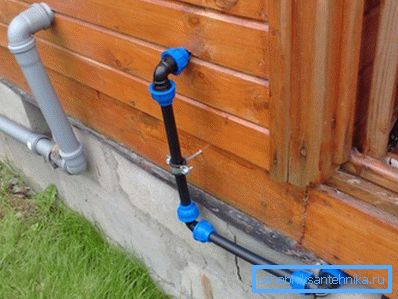
Physicochemical properties
We begin with a study of the basic properties of low-pressure polyethylene (HDPE).
- It is resistant to aggressive media and any biological effects.
Tip: alkalis and acids are supplied either in plastic containers or in glass with plastic jams.
- The material is elastic and resilient. Moreover, elasticity is maintained at low temperatures.
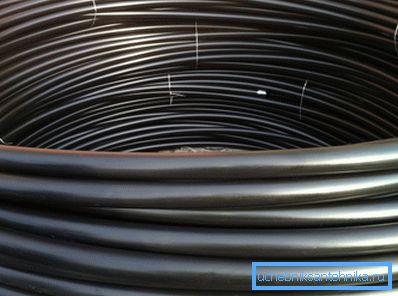
- Like all other polymers, polyethylene is a dielectric.
- The softening temperature is 80-120 degrees Celsius.
- Adhesive properties - at an extremely low level. Simply put, other substances do not stick to polyethylene. Water does not wet him either.
- The price of polyethylene is minimal among all plastics - both because of the manufacturability of production, and due to the low cost of gaseous raw materials.
Depending on the conditions of polymerization of the raw material - ethylene - there are three types of this plastic.
| Polymer type | Polymerization conditions |
| HDPE (Low Pressure Polyethylene) | 0.1 - 2 MPa, 120-150С |
| PSD (medium pressure polyethylene) | 3 - 4 MPa, 100 - 120С |
| LDPE (high pressure polyethylene) | 150 - 300 MPa, 200 - 260 С |
Note: obtaining PND and PSD requires a catalyst. The presence of oxygen is sufficient to initiate the formation of LDPE.
Of these materials, HDPE has the highest mechanical strength. It is he who is more often related polymers used for the production of pressure pipes.
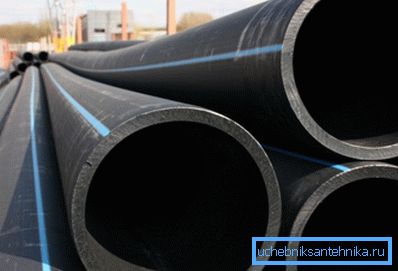
Compression fittings for pipes of small diameters are made from it, which allow to combine segments into an arbitrarily complex pipeline without using a tool.
Benefits
The study of the properties of the polymer allows us to formulate what, in fact, is so attractive summer water at the cottage of PND pipes on the background of alternatives - steel, metal, plastic, copper or polypropylene water.
- It costs significantly less than any other material.
- Installation of HDPE pipes for plumbing at the cottage does not require any tools other than a miter knife.
- The elasticity of the pipes allows you to lay the scourge with numerous bends.
- Due to the inertness to chemical and biological effects, pipes can be laid directly in the ground - this will not affect their service life.
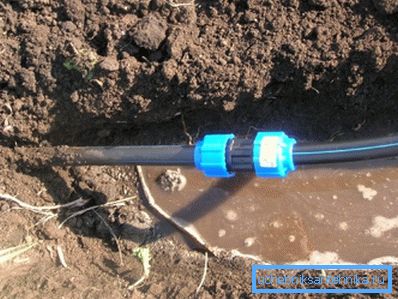
- Finally, the summer water supply from the PND in the country does not need to be dismantled for the winter. The frost resistance of plastic and its elasticity, which remains at low temperatures, makes it possible not to be afraid of the formation of ice jams. Even if the remaining water in the pipes freezes, the pipe will only stretch slightly, and after thawing it will return to its original size.
Water supply schemes
From the well
How to mount a water supply pipe from HDPE pipes in the country, if the source of water for it is the well located on the site?
The list of elements of the water supply system in this case will be as follows:
- Submersible pump (vortex or centrifugal). Vortex pumps are somewhat cheaper and more compact, but multistage centrifugal pumps are capable of transporting water with a large amount of impurities, while creating a pressure of tens of meters.
- Check valve, not giving water after stopping the pump to merge back into the well.
- Accumulator, accumulating water and creating excess pressure when the pump is off.
- Pressure sensor and relay, switching the pump on and off when the thresholds are reached.
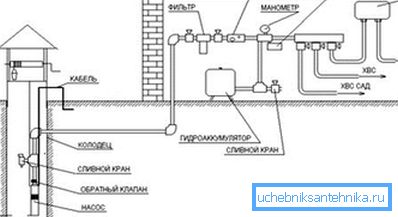
From the water garden garden association
A no less common scenario is when HDPE pipes for a water supply system at a dacha are connected to a network that supplies water on a schedule (from twice a day to once a week). It is clear that for permanent residence in the country this schedule can hardly be called comfortable.
Is it difficult to ensure a constant supply of water in this case?
- The main element of the scheme is a polyethylene water tank with a volume from 200 to 2000 liters (the volume depends on the schedule of water supply and its consumption). Capacity is installed in the attic of a country house, on a welded base or on a natural elevation.
- To fill the tank, a filling valve from the toilet cistern is used. It is installed in a hole cut in the container wall and sealed with standard gaskets.
- The drain pipe in the bottom of the tank is used to connect the local water supply.
- When installed in the attic, the tank can be equipped with overflow for safety reasons. At a level just above the valve, a sewer pipe with a diameter of 50 mm is inserted into the hole cut in its wall. Discharge from the tank is done in the sewer or on the beds; The pipe and wall connection is sealed with high-quality silicone sealant.
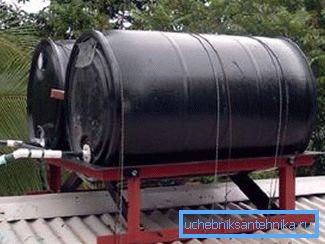
Installation
How to collect water from the PND in the country with their own hands?
There are a few subtleties here:
- Ensure that the O-rings enter between the pipe and the fitting. Seal jam is a typical cause of a compound leak.
- Do not forget to clean the connected surfaces of debris and dirt.
- Do not use tools to tighten connections. If the manually assembled fitting connection is leaking - disassemble it, correct the seals and reassemble.
- Do not bend the pipe with a small radius. She will not crack; however, the walls will collapse, dramatically reducing the capacity of the pipeline.
Attention: if instead of a trimmer knife you use a hacksaw for cutting the pipe, do not forget to remove the chamfer from the inner and outer surfaces of the pipe. The burrs will prevent you from wearing sealing rings.

Conclusion
As you can see, the construction of the water supply pipeline does not require any special knowledge or skills. The material recommended by us is not only practical, but also very easy to use. The video in this article will allow you to get a closer look at its installation. Successes!